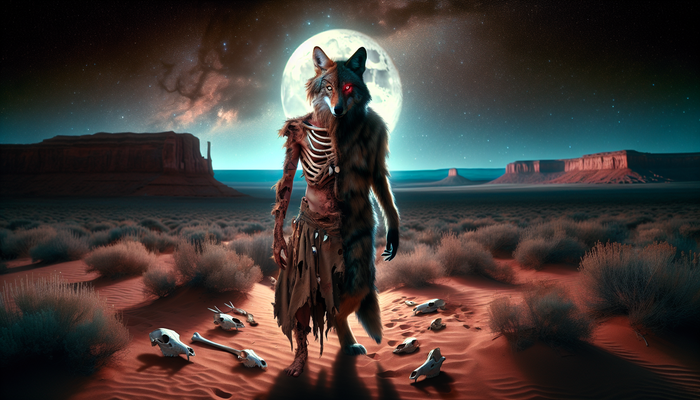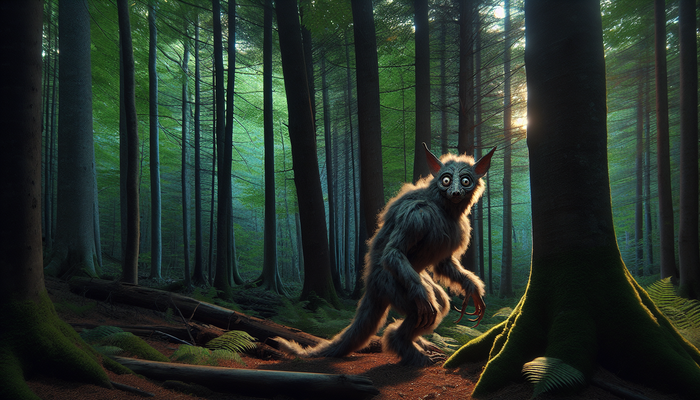Legendary Cryptids Lurking in the District of Columbia

By Dr. Elizabeth Harper, Cryptozoologist and Biologist
Introduction
In the heart of our nation's capital, where power and politics reign supreme, another force lurks in the shadows. The District of Columbia and its surrounding areas are a hotbed for legendary beasts known as cryptids. These mysterious and elusive creatures have captured the imaginations of locals and visitors alike for generations, weaving themselves into the fabric of the region's rich folklore.
As a seasoned biologist and historian in the cryptozoology community, I've dedicated my life to uncovering the truths hidden in the natural world. And when it comes to the enigmatic cryptids of D.C., I find myself irresistibly drawn to the challenge of unmasking these shadowy figures. Join me as we embark on a spine-chilling journey through the lore and legends surrounding the most famous cryptids stalking the District of Columbia.
The Sinister Snallygaster
Origins and Etymology
Our first stop on this supernatural tour is the Snallygaster, a fearsome creature that has haunted the region since the 1700s. The name "Snallygaster" itself has a fascinating origin, evolving from the German term "Schneller Geist," which translates to "quick spirit." It's a fitting moniker for a beast said to move with lightning speed and strike terror into the hearts of those who cross its path.
The legend of the Snallygaster was first reported by German immigrants who settled in the area, bringing with them tales of a dragon-like creature that stalked the countryside. Over time, the name morphed into the peculiar "Snallygaster" we know today, a testament to the way folklore evolves and adapts as it passes through generations and cultures.
Description
So, what exactly is the Snallygaster? Accounts vary, but most agree that this cryptid is a terrifying sight to behold. Imagine a chimera, a monstrous amalgamation of various creatures. The Snallygaster is often described as having features of a dragon, a bird, and, most bizarrely, tentacles protruding from its mouth.
Yes, you read that right. Tentacles. In its mouth.
Some reports paint the Snallygaster as a dragon with a single, cyclopean eye, while others emphasize its birdlike qualities, such as wings and a sharp beak. But the most unsettling detail, the one that sets the Snallygaster apart from other dragon-like cryptids, is the presence of those writhing, serpentine tentacles. It's a feature that adds an extra layer of otherworldly horror to an already frightening creature.
Early 20th Century Sightings
While the Snallygaster's origins lie in the 1700s, it was in the early 20th century that this cryptid really made a name for itself. In 1909, the Middletown Valley Register, a local newspaper, published a series of articles about a "one-eyed dragon" terrorizing the good people of Western Maryland. The beast was said to swoop down from the sky, snatch up livestock and even small children, and carry them off to its lair.
The Snallygaster's reign of terror didn't stop at the Maryland border, either. Sightings were reported in neighboring West Virginia, suggesting that this winged menace had a wide hunting range. The stories became so widespread that even President Teddy Roosevelt allegedly took notice.
According to local legend, Roosevelt was so intrigued by the Snallygaster stories that he considered postponing an African safari in 1909 to hunt the beast himself. While this tale remains unconfirmed, I can't help but imagine the bespectacled, mustachioed president tramping through the Maryland woods, trusty rifle in hand, in hot pursuit of his tentacled quarry. It's a mental image that perfectly captures the Snallygaster's place in the public imagination at the time.
The Snallygaster's Demise
After the flurry of sightings in 1909, the Snallygaster faded into relative obscurity for a time. But like any good monster, it couldn't stay hidden forever. In 1932, the Snallygaster made headlines once again, reigniting the public's fascination with this bizarre creature.
According to local lore, the Snallygaster met a rather ignominious end that year. The story goes that the beast was attracted to the potent fumes wafting from a moonshiner's vat of whiskey mash. Unable to resist the allure of the alcohol, the Snallygaster flew too close to the vat, became overwhelmed by the fumes, and drowned in the intoxicating liquid.
It's a strange and somewhat anticlimactic conclusion to the Snallygaster's story, but one that's in keeping with the cryptid's quirky reputation. I can't help but wonder if the moonshiner in question ever tried to sell that batch of "Snallygaster-infused" whiskey. It would certainly make for a unique selling point!
The Demon Cat of Capitol Hill
Appearance and Behavior
Leaving the rural wilds of Maryland behind, we now turn our attention to the heart of Washington, D.C., where another cryptid is said to prowl the halls of power. The Demon Cat, or "D.C." for short (see what they did there?), is a spectral feline that haunts the basement of the U.S. Capitol building.
Eyewitnesses describe encountering what appears to be an ordinary, unassuming tabby cat slinking through the shadowy corridors. But as the observer approaches, something strange and terrifying happens. The cat begins to grow, its form shifting and swelling until it reaches an enormous size.
Just when the unfortunate witness thinks things can't get any more bizarre, the Demon Cat lets out an unearthly yowl and leaps toward them, its eyes glowing with malevolent intent. But before the beast can make contact, it vanishes into thin air, leaving the observer questioning their sanity and the very nature of reality.
History of Sightings
The Demon Cat's appearances have been documented for well over a century. The first official record of this spectral feline dates back to the Civil War era, when it was mentioned in the Congressional Record. Even then, it seems, the Demon Cat was up to its old tricks, materializing out of the darkness to terrorize unsuspecting passersby.
In 1935, The Washington Post published an article that delved into the Demon Cat's legend. The piece described the cat's glowing eyes and the aura of ferocity that surrounded it, painting a vivid picture of this Capitol Hill haunt. It's clear that the Demon Cat had already cemented its place in local lore by this time.
Haunting Grounds
While the Demon Cat is most commonly associated with the U.S. Capitol building's basement, it seems this ghostly feline doesn't limit itself to just one haunt. Sightings have also been reported in the White House, suggesting that the Demon Cat has a taste for the corridors of power.
I have to wonder if the Demon Cat has ever interrupted a late-night Oval Office meeting or caused a visiting dignitary to do a double-take. It's a amusing thought, imagining world leaders and politicians being caught off guard by a spectral cat leaping out of the shadows.
Ongoing Legend
Despite its long history, the legend of the Demon Cat shows no signs of fading away. Capitol Hill staffers still whisper about this feline phantom, swapping stories and warning newcomers to keep an eye out for any unusually large tabbies prowling the basement.
As a cryptozoologist, I have to approach these tales with a healthy dose of skepticism. But I also can't help but be intrigued by the sheer longevity of the Demon Cat legend. Whether there's any truth to the stories or not, the fact that they've persisted for so long says something about our fascination with the unknown and the unexplained.
So, if you ever find yourself wandering the halls of the U.S. Capitol late at night, keep your wits about you. And maybe bring some catnip, just in case. After all, you never know when you might come face to face with the infamous Demon Cat.
The Fearsome Bunnyman
Origins in Fairfax County, VA
Hopping across the Potomac River, we find ourselves in Fairfax County, Virginia, the stomping grounds of one of the most bizarre cryptids on our list: the Bunnyman.
The origins of the Bunnyman legend are as murky as they are unsettling. According to one popular version of the tale, the story begins in the early 1900s with a breakout at a nearby asylum. The asylum, which housed the criminally insane, was shuttered, and its patients were to be transferred to a new facility. But during the transfer, one of the buses transporting the patients crashed, allowing its dangerous cargo to escape into the surrounding woods.
Most of the patients were eventually rounded up, but one, Douglas Grifon, remained at large. In the days that followed, a grisly scene was discovered in the forest: a trail of half-eaten, mutilated rabbit carcasses, hanging from the trees like some sort of macabre decoration. Despite an extensive search, Grifon was never found, and the area was left with a chilling new legend: the Bunnyman.
1970s Reign of Terror
The Bunnyman legend might have faded into obscurity if not for a series of bizarre events in the 1970s that thrust this cryptid back into the spotlight. In October of 1970, a young couple was parked in a car near the infamous "Bunny Man Bridge" in Fairfax County. Without warning, a figure emerged from the darkness, brandishing an axe. But this was no ordinary attacker. The figure was dressed in a white bunny costume, complete with long ears and a fuzzy tail.
The couple watched in horror as the Bunnyman began hacking at their car with his axe, screaming incoherently. They managed to escape, but not before the Bunnyman hurled his weapon through the car's window, narrowly missing the terrified occupants.
Just weeks later, a security guard at a nearby unoccupied house had his own run-in with the Bunnyman. The guard spotted the figure, still clad in his bunny costume, chopping at the house's front porch with an axe. When the guard approached, the Bunnyman whirled around and screamed at him, ranting about trespassing.
These incidents, which were reported in local newspapers at the time, cemented the Bunnyman's place in the annals of Virginia folklore. Suddenly, this axe-wielding figure in a bunny costume became the stuff of legend, a boogeyman used to scare children and thrill-seeking teenagers alike.
Bunnyman Bridge's Enduring Allure
The epicenter of the Bunnyman legend is a small, unassuming bridge in Fairfax County, now known as "Bunny Man Bridge." It's here that the Bunnyman is said to lurk, waiting for unsuspecting victims to cross his path.
Over the years, Bunny Man Bridge has become a magnet for thrill-seekers and curiosity-seekers alike. Many locals have made a tradition of visiting the bridge on Halloween night, hoping for a glimpse of the infamous Bunnyman. Some even claim to have seen the figure darting through the woods or heard the sound of his axe echoing in the darkness.
As a cryptozoologist, I have to approach these accounts with a healthy dose of skepticism. After all, the human mind has a way of playing tricks on us, especially in the dark and in the presence of a powerful legend. But I also can't discount the possibility that there may be a kernel of truth buried somewhere in the Bunnyman story.
Perhaps the legend is based on a real person, a disturbed individual who donned a bunny costume and terrorized the community. Or maybe the Bunnyman is a manifestation of our collective fears, a boogeyman conjured up by our imaginations to embody the unknown dangers that lurk in the shadows.
Whatever the truth may be, one thing is certain: the Bunnyman has left an indelible mark on the folklore of Fairfax County. And as long as there are dark woods and lonely bridges, there will be those who whisper his name and wonder if he's still out there, waiting for his next victim.
Chessie: The Chesapeake Bay's Sea Serpent
Named in homage to the Loch Ness Monster
Moving from land to sea, we come to the tale of Chessie, the legendary sea serpent said to inhabit the waters of the Chesapeake Bay. Chessie's name is a playful nod to the bay's location and a wink to another famous cryptid: the Loch Ness Monster, affectionately known as "Nessie."
It's fitting that Chessie would be named after its Scottish cousin, as the two cryptids share many similarities. Both are said to be long, serpentine creatures with a penchant for popping up unexpectedly and sparking the imaginations of those who claim to have seen them.
Sightings date back to 1936
Chessie may not have the centuries-long history of some of the other cryptids on our list, but this sea serpent has still managed to make quite a splash in the relatively short time it's been part of the public consciousness. The earliest reported sighting of Chessie dates back to 1936, when a fisherman claimed to have seen a long, snake-like creature undulating through the waters of the bay.
Since then, there have been sporadic sightings of Chessie throughout the decades. Each report adds a new layer to the legend, with eyewitnesses describing a creature that seems to defy explanation.
Descriptions paint Chessie as a long, snake-like creature
So, what does Chessie look like? Descriptions vary, as they often do with cryptids, but there are some common threads that run through the sightings. Most eyewitnesses agree that Chessie is a long, serpentine creature, not unlike a giant snake or eel.
Some reports get more specific, describing Chessie as having a horse-like head and flippers instead of fins. This description has led some to speculate that Chessie could be a surviving prehistoric reptile, a relic from the time of the dinosaurs that has somehow managed to avoid detection in the modern era.
One of the most intriguing Chessie sightings came in 1980, when a farmer claimed to have seen a 30-foot-long creature swimming in the Potomac River. The farmer, who wished to remain anonymous, described the beast as having a snake-like body and a head that resembled a horse's.
This sighting sparked a flurry of speculation about Chessie's true nature. Some experts suggested that the creature could have been an escaped anaconda, a giant snake native to South America that had somehow found its way to the Chesapeake Bay. Others dismissed the sighting entirely, chalking it up to a case of mistaken identity or an overactive imagination.
From Bigfoot to UFOs: Hangar 1 Publishing Has You Covered!
Explore Untold Stories: Venture into the world of UFOs, cryptids, Bigfoot, and beyond. Every story is a journey into the extraordinary.
Immersive Book Technology: Experience real videos, sights, and sounds within our books. Its not just reading; its an adventure.



























